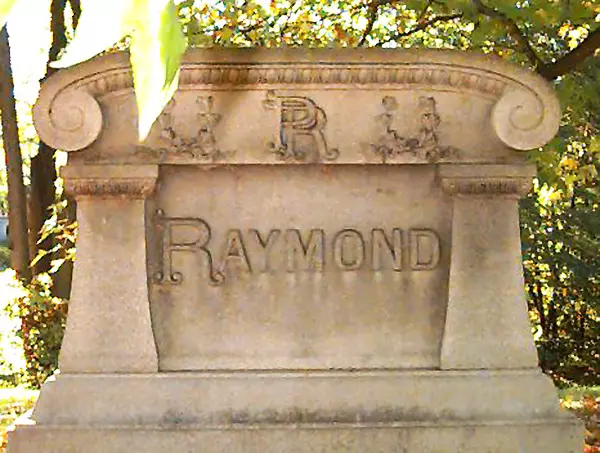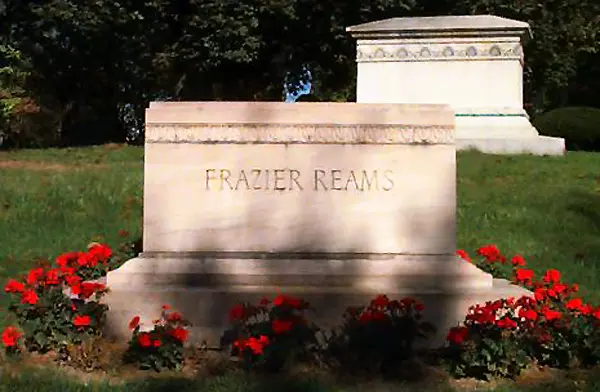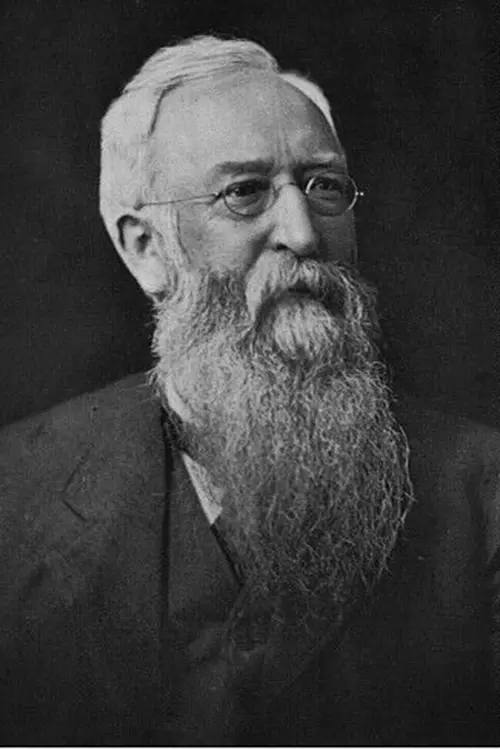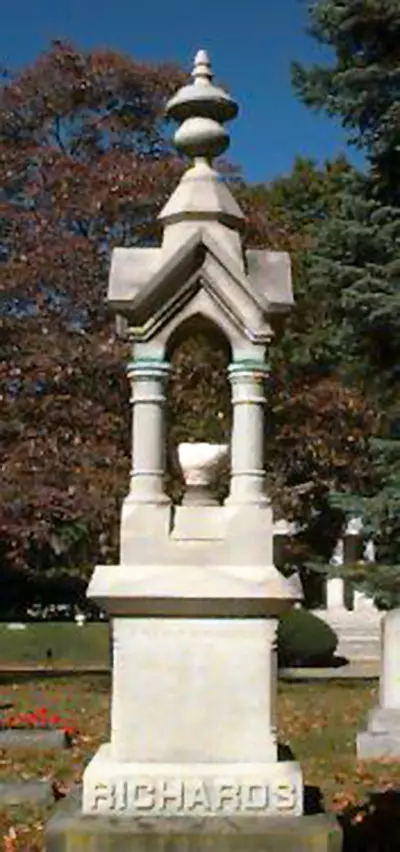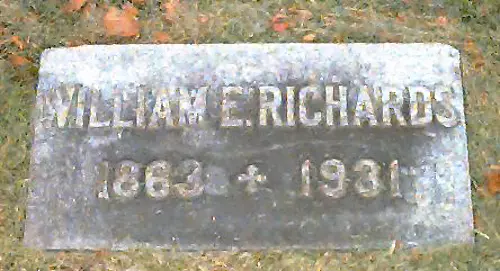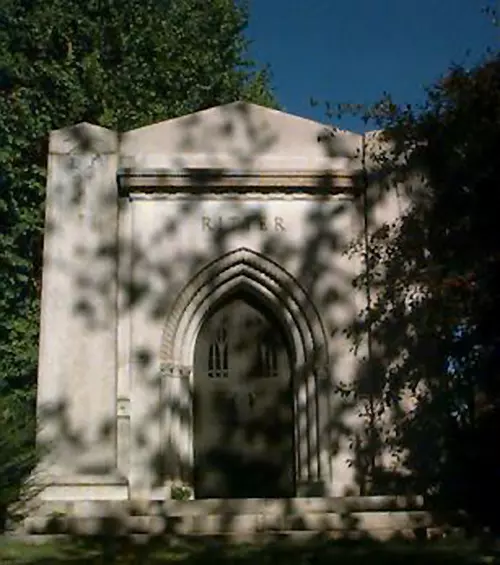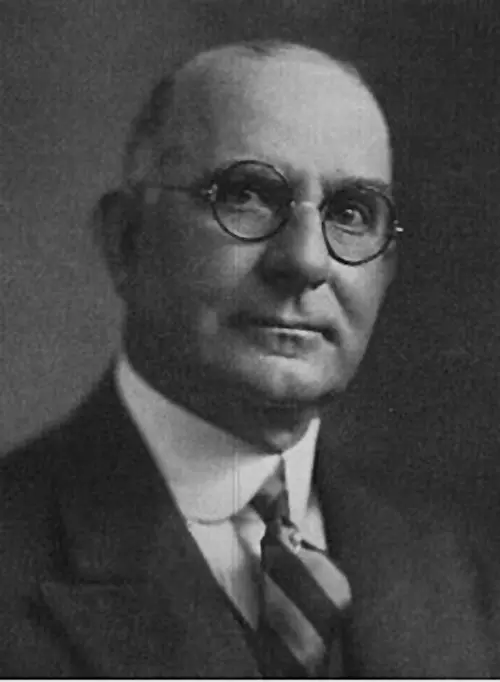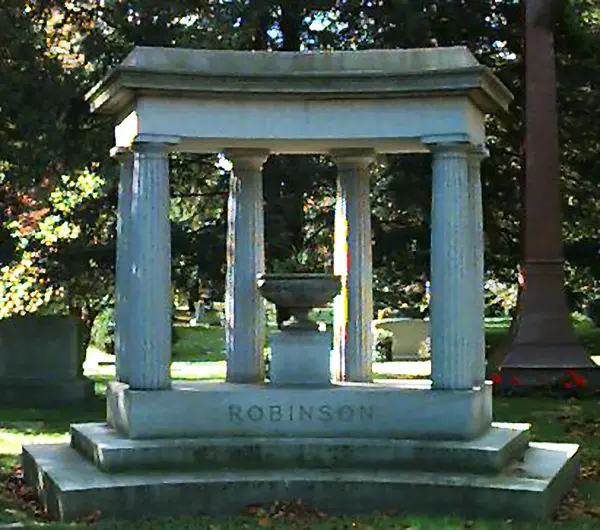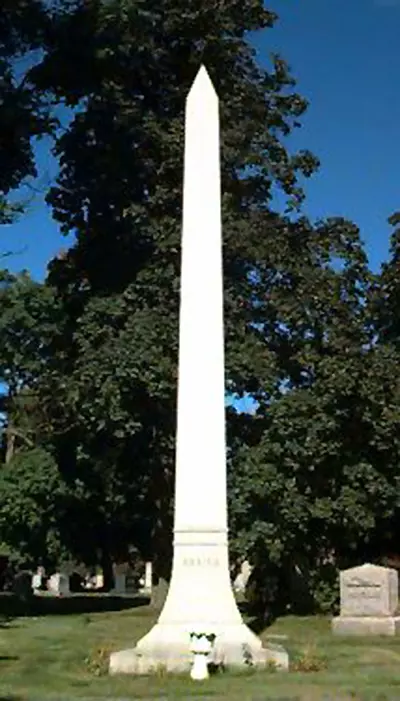Erwin P. Raymond - Colonel William H. Raynor - Frazier Reams - Dr. Calvin Hamilton Reed - S.C. Reynolds and W. B. Reynolds - Ramson Richards - William Edgar Richards - George W. Ritter - Jefferson D. Robinson - Horton C. Rorick
Erwin P. Raymond
Erwin P. Raymond was a prominent Toledo attorney, a member of City Council and the Police Board, a trustee of the Toledo Public Library, and City Solicitor.
Raymond was born in Adrian, Michigan on March 9, 1845, the son of Paul and Marriet (Southworth) Raymond. His family moved to Toledo in 1866. His father, a native of New Hampshire, was a successful merchant and a well-known realtor in Toledo.
Raymond attended the public schools of Toledo. He graduated with a law degree in 1871 from Michigan State University and was admitted to the Ohio Bar. He entered a partnership with Charles Dodge under the firm name of Dodge & Raymond. They practiced law together for twelve years and then Raymond conducted his general law practice alone.
In October, 1875 Raymond married Margaret L. Johnson with whom he had three children. Paul Raymond died March 15, 1900 at the age of 90. Clara Belle Raymond, daughter of Erwin and Margaret died January 6, 1904 at the age of 20. Margaret L. Raymond died July 7, 1906 and Erwin P. Raymond, Jr. died July 15, 1923. (Portrait and Biographical Record of the City of Toledo and Lucas County. (Chicago: Chapman Publishing Co., 1895, pp.392, 395.)
Colonel William H. Raynor
Colonel William H. Raynor volunteered at the outbreak of the Civil War and joined the First Ohio Regiment. While fighting at the first battle of Bull Run he was taken prisoner and sent to Libbey Prison in Richmond, Virginia. He escaped and after 17 days reached safety. The story goes that while he was trying to reach Union lines, after escaping from prison, a Southern soldier spotted him and was going to shoot Raynor but when he saw his Masonic pin allowed the escapee to pass by. When he reached home he organized the 56th Ohio Regiment and was made colonel. He was later wounded at the Red River Landing just below Vicksburg on the Mississippi and was decorated for bravery.
At Red River Colonel Raynor gave the command for his men to disembark from the boats. The men on the lower decks did not hear his order and he did not realize that most of his regiment were still on the boat until he was at the top of the hill. He ordered his aide to go back alone to get the remaining troops but because his aide was afraid Raynor went himself and subsequently was shot in the leg. Following the war, Colonel Raynor became a Brigadier General in the veterans' organization Grand Army of the Republic.("Needs of Veterans or Their Widows Occupy the Attention of Kate Raynor," Toledo Times, 26 July 1937).
Colonel Raynor's daughter, Kate G. Raynor, devoted her life to Toledo's patriotic organizations. She was born in West Liberty, Ohio, but lived in Toledo over sixty years. Kate Raynor, like her father, was very involved in the Grand Army of the Republic. She first served as President of the Women's Relief Corps (W.R.C.) of the G.A.R. In 1930, Kate became national President of the WRC. She was national president of the G.A.R.s Auxiliary to the Sons of Union Veterans. She was also active in the Soldiers' and Sailors' Relief Commission. In about 1928 she was chosen to serve as its secretary.("Kate G. Raynor," Toledo Blade, 11 September 1951). The Commission collected county funds which it then distributed to veterans of wars. Part of the money gathered was given to organizations such as the American Legion, American Red Cross, Disabled War Veterans and Veterans' of Foreign Wars.
Kate Raynor served in other organizations including the Daughters of the American Revolution and the Forsyth Relief Corps. A Toledo Times article of 26 July 1937, quoted her belief that America had never been prepared for war. She compared a country with an inadequate defense to a man who will not leave his home without locking the doors.("Needs of Veterans.") Kate Raynor died on September 10, 1951 after an illness of eight years.("Kate G. Reynor.")
Frazier Reams
Frazier Reams was one of the most interesting and vibrant men to have ever called Toledo home. He was involved in business, law, politics, and the beginning of the radio and television industries of Toledo.
Frazier Reams was born on Jan. 15, 1897, in Franklin, Tennessee. His father was a Methodist Minister.(Toledo Biography Scrapbook, Local History Room, Toledo Lucas County Public Library). After attending a preparatory school, Reams began taking classes at the University of Tennessee. His education was interrupted by the U.S. entry into World War I in 1917. He joined the army and eventually became a 2nd Lieutenant in a field artillary regiment. After the war he returned to the University of Tennessee and earned his degree in 1919. He received his law degree from Vanderbilt University in 1922.[Charles S. VanTassel, ed., Story of the Maumee Valley, Toledo and the Sandusky Region, vol.3 (Chicago: S.J. Clarke Publishing Co., 1929), p.186]. After graduation, he came to Toledo to visit his brother who was studying to be a Doctor. He fell in love with the city and he decided to make his home here.
After moving to Toledo he joined the law firm of Tracy, Chapman, & Welles. He later left the firm to take the position of an assistant trust officer of the Commercial Savings and Trust Company. Two years later he was made a trust officer. He was eventually made vice-president.(Toledo Biography Scrapbook). In 1926 he was elected commander of the Toledo Post of the American Legion. In 1927 and 1928 he served on the Legion's State Executive Committee.[(Van Tassel, p.187). Harry R. Lilman, Unholy Toledo (San Francisco: Polemic Press Publications, 1985), pp.156-62].
In 1928 Reams made his first foray into politics. That year he was a delegate to the Democratic National Convention. In 1932 Reams was made the County Prosecutor. Prohibition had resulted in the creation of powerful gangs around the country and Toledo was no exception.(Toledo Biography Scrapbook.) The most famous gang was the Purple Gang, with Tony Lacovoli as leader. Into this situation stepped Reams. He organized a group of investigators to carry out his orders. It was with this core group that he prevailed in a famous trial, State of Ohio vs Thomas (Yonnie) Licavoli.
During the trial Reams proved Licavolis duplicity in the murders of Abe Lubitsky, Norman Blatt, Jack Kennedy and girlfriend Louise Bell. The American Legion at this time supported Reams fully. They gave warning to Toledo's criminals that they would kill them if Reams or his family were harmed. Reams earned the title, ("The Man Who Saved Toledo."Lilman, pp.156-62). This trial brought national exposure to Reams and helped him to receive an appointment by President Roosevelt as Democratic Campaign Chair in Ohio.(Toledo Biography Scrapbook.)
His dealings with Licavoli were not over. Ten years later he was called in when there were rumors of special privileges in prison for gang leaders. It took Reams only six weeks to clean up corruption in the prisons. For his efforts he was appointed director of Public Welfare in Ohio by Governor Lausche who had defeated him in the election for Governor that year. During his time as the director he raised $5 million for a new central prison and implemented programs for the reform of the state prisons. Most notably he attacked idleness and encouraged work for the prisoners. His motto was: Idleness is the Devils Workshop.
During the late 1930's Reams got back into politics. His political aspirations were renewed by a couple of unsuccessful runs for Ohio Attorney General in 1936. Three years after his failed runs, he was appointed a collector of Internal Revenue. After the U.S. entered World War II he was made Director of the 5th Regional Office of Civilian Defense.
Reams then ran for Governor twice and lost. He also ran for the Senate and lost. In 1950 he ran for the House of Representatives as an Independent and won. It was one of his greatest triumphs. He was the only Independent and the first to be elected in 20 years when he took his seat in the House. He received the special privilege of being chairman of the Subcommittee of the House Post Office and Civil Service Committee, which is extremely rare for a freshman. He also served on the House Committee on Organized crime. Frazier Reams was a supporter of the St. Lawrence Seaway, liberalization of immigration laws, and the direct Presidential primary.(The Blade, September 15, 1971). In 1952 he won reelection in another three way race. He was already one of the most respected members of the House. During the next election Reams luck ran out and he was defeated in his reelection (ibid).
During this time Reams was busy in other areas. In 1937 he formed his own law firm. Also that year he, along with Thomas Betherton and Morton Niepp, formed the Community Broadcasting Corporation. Which had the call letters for am and fm of WTOL. This would eventually became Channel 11 in 1958. He was involved in both the radio and television stations until they were sold in 1965. He later bought back the radio station which had been renamed WCWA.
Reams was also on the commission that created the Toledo Port Authority. He served as vice chairman from its creation in 1955 until 1963. On September 15, 1971, Reams died. He was survived by his wife and two children.
Dr. Calvin Hamilton Reed
Dr. Calvin Hamilton Reed was a distinguished general practitioner, professor of obstetrics, and co-founder of the Toledo School of Medicine.
Reed was born on November 20, 1840 near Milford Center, Ohio, the son of George and Martha Reed (Morgan). He was born on the farm of his grandfather, who had been one of the earliest pioneers in the area. He received his early education in the Union County rural district school. His parents could not afford to pay for his higher education, so from the age of 18 until he was 20 Reed taught school during the winter and worked on the farm during the summer to save money. By 1860 he was able to enter the Marysville Academy.
After three years of study at the academy, Reed enlisted in the Union Army for three months, serving as a Corporal in Company E, Eighty-Sixth Ohio Volunteer Infantry which was stationed in Clarksburg, West Virginia.
After his service was completed, Reed entered Ohio Wesleyan University where he taught part-time and finished his education. In the summer of 1865, he taught school at Milford Center and in the fall he began his study of medicine in the office of Dr. John W. Hamilton, Professor of Surgery at Starling Medical College in Columbus.
Reed graduated from Starling in 1868 and moved to Toledo to start his practice. In 1878 he helped organize the Toledo School of Medicine at which he lectured on obstetrics. He later was elected to the chair of Professor of Obstetrics at the Northwestern Ohio Medical College.
Outside of his practice, Reed contributed to medical literature and served on the Toledo, State and Northwestern Ohio Medical Associations. He participated in community affairs by serving on the Toledo Board of Education and by joining the United Workmen. He also served as Chancellor of the Knights of Pythias, was a member of the Masonic Order, and a member of Toledo's Third Presbyterian Church.
Reed was married June 9, 1869 to Miss Emma Bithiah Smythe and was the father of five children. He died May 4, 1915 at the age of 75.[Clark Waggoner, ed., History of the City of Toledo and Lucas County, Ohio (Toledo: Munsell & Co., 1888), pp.552-53. See also Harvey Scribner, Memoirs of Lucas County and the City of Toledo, vol. 2 (Madison: Western Historical Association, 1910), pp.344-45].
S.C. Reynolds and W. B. Reynolds
The Reynolds brothers success in the grain market and in banking made them one of Toledo's prominent families. The first Reynolds who was a leader in Toledo business was Sheldon Clark Reynolds. Known as Colonel S.C. Reynolds, he was born November 19, 1835. His brothers, Wiley R. and William B. Reynolds had formed a general dry goods business in Jackson, Michigan. When S.C. was sixteen he joined the firm as a clerk and three years later bought out Wiley's interest. A year later, in 1855, William transferred his interest in the company to Wiley. For the next fourteen years the firm was known as W.R. and S.C. Reynolds. In 1869 the business moved from Jackson to Toledo where it changed its name to Reynolds Brothers. In Toledo the partners bought the Armanda flouring mills which became prosperous. Three years later William sold his share of the company to his two brothers.
The Reynolds Brothers sold the flouring mills in 1875 when they entered the grain commission business. At that time Wiley's son Charles became a partner in the firm. In 1875 the Reynolds Brothers handled 2,000 carloads of grain, but by 1885 they were carrying 85,000 carloads a year. A large part of their success was due to the fact that S.C. Reynolds was the first grain dealer to bring wheat west of the Mississippi and Missouri rivers. In the year 1885 they were the largest firm of their kind in the United States. S.C. Reynolds was a leader in creating the produce exchange and was its largest stockholder.
S.C. Reynolds eventually became involved in transportation and banking. He was at one time the president of First National Bank and was chairman of the board of directors until his death.[John M. Killits, ed. Toledo and Lucas County, Ohio, 1623-1923, vol. 3 (Chicago: S.J. Clarke Publishing Co., 1923), p.542]. He also sat on the board of directors of the Toledo Savings Bank and Trust Company. S.C. Reynolds was the director of several railroads including the Wabash, Hocking Valley, and the Kanawha and Michigan. He was president of the Lake Erie Transportation Corporation and one of the transport companys major ships bore his name.[Charles S. Van Tassel, ed., Story of the Maumee Valley, Toledo and the Sandusky Region, vol. 4 (Chicago: S.J. Clarke Publishing Co., 1929), p.625]. Eventually his interests in banking and transportation became so important that the Reynolds Brothers company disbanded in 1908.(Winter, History of Northwest Ohio, vol. 2). S.C. Reynolds was married to Martha and they were the parents of four children. He died on November 22, 1912.(Killits, vol. 3, p.535).
Charles Louis Reynolds (66-40) was the nephew of S.C. He was born in Jackson, Michigan on March 29, 1851. In 1875, after completing college, he joined Reynolds Brothers. In 1886, he became involved in directing the Toledo Savings Bank & Trust Company. Twenty years later he was made president of the bank. He was, in addition, a director and one of the largest stockholders of the Second National Bank. Eventually both banks merged with the Toledo Trust Co. And Reynolds became vice-chairman of the board at Toledo Trust after the merger. Charles Reynolds also was a director of the Toledo Scale Co. and president of the Merrill Manufacturing Co. He was married to Annie Groff. He retired in 1931 and on July 5, 1938, he died after an illness of several weeks.(Killits, vol. 3, 626. "C.L. Reynolds, Banker, Dies," Toledo Blade, 5 July 1938. "Reynolds. Dead at 87," Toledo New Bee, 5 July 1938).
Frederick Jesse Reynolds, the son of S.C. Reynolds, joined his fathers business the Reynolds Brothers and later also went into banking. He was born in Jackson, Michigan on August 25, 1857. After college he became a clerk at Reynolds Brothers and five years later was made a partner. He stayed with the company until it broke up in 1908 but by then had already expanded into other businesses. In 1887 he became vice-president and general manager of the Toledo and Michigan Belt Railway Company and held that position until the company was absorbed by the Michigan Central Railway. Like his father, Frederick Reynolds became an executive and member of the board at First National Bank. He was elected to the board of directors of the bank in 1897. He became vice-president in 1898 and finally achieved the presidency of the bank in 1909.(Killits, vol. 3, p.557). In 1923, Reynolds was made chairman of the board of directors at First National.("F.J. Reynolds, Bank Leader, Is Dead Here," Toledo Times, 2 April 1932). He was also on the board of directors of the Hocking Valley Railroad Co. and the Mather Spring Co. He was a member of the New York Produce Exchange and the Toledo Chamber of Commerce.(Van Tassel, p.627). He married Ida Louise Stone on October 4, 1882. Ida Reynolds died in 1915. Frederick Reynolds died on April 1, 1933 after an illness of several months.("H.S. Reynolds: Retired Banker, Hospital Trustee," Toledo Blade, 22 October 1967).
Frederick's son, H.S. Reynolds, followed a path very much like his father's. H.S. Reynolds was born in Toledo on February 1, 1885. He attended the Toledo Public Schools before graduating from St. Paul's School at Garden City, Long Island in 1900. He worked for Reynolds Brothers after he graduated from the University of Michigan in 1906. After Reynolds Brothers, he obtained a minor position with First National Bank and by 1912 was on the board of directors. In 1915 he was made vice-president and in 1923 followed his father as president. At that time he was the youngest bank president in the country. H.S. Reynolds was also on the board of directors of the Toledo Trust Company and Rossford Savings bank.
H.S. Reynolds married Rachael Ketchum in February 1909. He lived in the Plaza hotel in his later years and died in the Lucas County Home on October 21, 1962.
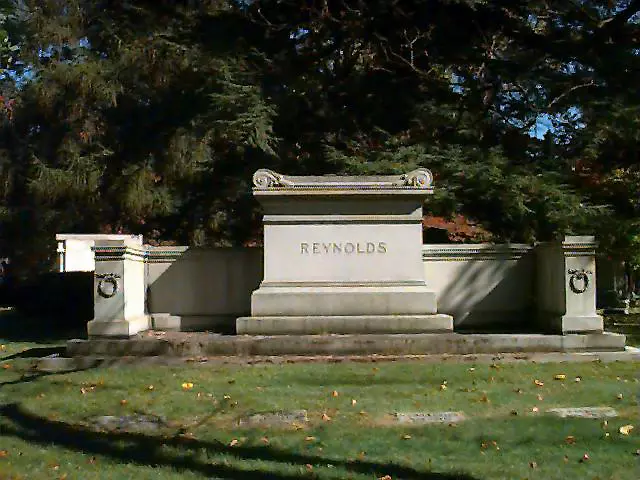 S.C. Reynolds's and W. B. Reynolds's grave
S.C. Reynolds's and W. B. Reynolds's grave
Ramson Richards
Ramson Richards was the son of William and Eliza Richards. The Richards traced their lineage back to the Pilgrims. Ramson was born on October 13, 1833 in Candice, Onatrio City. When he was four years old Ramson's mother died. In February of 1842, Ramson and his family moved to Chesterfield Township, Ohio.Waggoner, [History of the City of Toledo and Lucas County, Ohio, vol. 2 (New York: Monsek & Company Publishers, 1888), pp.727-728. For a picture, see p.726]. Richards spent the following ten years working to clear the land and he was often called upon to travel to Toledo's grist mills. The journey was a four day trip.
As a young boy, Richards wrote a few credible articles. As he grew older, Richards started a productive writing and newspaper career. This started with his submission of two poems: "A Golden Sunset" which was printed in the Perrysburg Star and "The Western Wilds" which appeared in the Toledo Republican.
From there he became apprenticed to the Toledo Commercial Republican where he gathered news and copied telegraph reports.(Toledo Biographical Scrapbook, Local History Room, Toledo Lucas County Public Library). From there he went on to become a reporter for the Toledo Blade as the local and commercial reporter. He remained at this post until 1853 when ill-health forced him to move to Michigan. In 1855, Ramson Richards returned to Toledo and his job at the Toledo Blade.
After returning to Toledo, he was active as the author of books on such diverse topics as the Masons and a Toledo business directory. At the same time he was farming some acreage of land that was located next to Woodlawn Cemetery. Richards dabbled in real estate from 1867-1871. In 1876, Richards sold his farm and moved to Parkwood Avenue. While on a trip to Florida in April of 1886, Ramson Richards developed a severe cold. He died there on April 15 of that year.
William E. Richards
William Edgar Richards was an electrical engineer from Toledo. He had the honor of designing the lighting for the Statue of Liberty. Richards was born around the year 1863 and in 1891 he came to Toledo from Iowa. Soon after his arrival he found work with the Toledo Consolidated Street Car Company. He stayed through several reorganizations of the firm which eventually became known as the Toledo Edison Company. Richards stayed with the company until his death.("Power Company Official, Stricken at Desk, Dies," Toledo Times, 13 August 1931).
Richards became nationally known for the advances he made in electrical transmissions. These included the use of underground cables."Toledo Man Provided Light for Statue of Liberty, Newly Released Letters Detail Role of Engineer." Richards installed a 23,000 volt system of underground cables in Toledo. At the time, only one other city in the nation possessed a system like it.("Power Company Official.") In 1916, W.E. Richards success attracted the attention of those who were working on a plan to light the Statue of Liberty. Public contributions had raised the money to fund the project and Richards was asked to review the lighting plans.
Richards made several suggestions including running a half mile of cable under upper New York Bay to Bedloe (Liberty) Island. He advised putting clusters of 15 to 20 spotlights along the eleven points of the statue's base. Finally, Richards wanted to light the torch with a set of flashing lamps. The power would be provided by a cable run up to the torch.
Richards soon found himself on leave from Toledo Edison and in charge of the project. It was the middle of October at the time and the lighting ceremony was set for December 2, 1916. The following two months were full of obstacles for Richards. The official government engineer called his plans the "worst set of plans ever submitted to the government."
Nothing was changed and it appeared Richards would finish the project. Just then, the cable manufacturing company told him it would take five months to complete his order. They told him if they produced no orders but his it could be done in 10 days. Richards appealed for the government, the media, and the electrical industry to pressure the company. The cable manufacturer gave in to the pressure. The company provided the wire in only four days rather than the ten days it said it would take. The project was finished two days ahead of schedule. On December 2, 1916, President Wilson pushed the button to start the procedure and the Statue of Liberty was bathed in light.
For his efforts, W.E. Richards received a gold medal from the City of New York. He then returned to Toledo and continued to work for Toledo Edison. He was dictating to his stenographer when he died on August 12, 1931.(Ibid).
George W. Ritter
George W. Ritter was a prominent Toledo attorney and philanthropist who made possible the building of the University of Toledo's Ritter Planetarium and Observatory, the Mary Ritter Hall and the law center at Lake Erie College in Painesville, Ohio. He also endowed two scholarships for UT law students.
Ritter was born in Vermillion, Ohio on June 30, 1866. He graduated from Baldwin University in Berea, Ohio. In 1906 he received his law degree from Cleveland Law School. He opened a private practice in Sandusky in 1907 but came to Toledo in 1913 to be a partner in the firm of Kohn, Ritter, Northup, and McMahon.
In 1917 he established his own firm in partnership with Leland Gardner. He began an association with the former Willys Corporation in 1925 when he became counsel to John North Willys, the founder of the company. Ritter, H.J. Leonard, and Ward M. Canaday organized Empire Securities, Inc, a holding company, in 1932. This company was established in order to process claims against Willys. In 1936 the firm was reorganized as Willys-Overland Motors, Inc.
Ritter served as the secretary of Willys-Overland from 1936-46; as vice-president from 1944-53; and as general counsel from 1936-53. His association with the company ended in 1953 with its sale to the Kaiser-Frazer Corporation.
In January of 1928, Ritter was named city law director by Mayor William Jackson, but he resigned in October of 1929 following a controversy with Municipal Judge Ira W. Cole.
Ritter remained active in law practice with the firm of Ritter, Boesel, Robinson & Marsh for a number of years as well as managing various office buildings. He was involved in a number of community organizations including the Toledo Club, The Toledo Country Club, the Inverness Club, the Maumee River Yacht Club, and the Toledo Chamber of Commerce. His community activities included serving on the board of trustees for The Toledo Hospital, the Toledo Museum of Art, Baldwin-Wallace College, and the YMCA.
Ritter was married to Mary Fowler on June 30, 1911. He died June 23, 1979 at the age of 92.[(The Blade, June 24, 1979). See also John Killits, Toledo and Lucas County, Ohio 1623-1923. vol.3 (Chicago: S.J. Clarke Publishing Co., 1923)].
Jefferson D. Robinson
Robinson was born in Richmond, Virginia on July 19, 1861. He came to Toledo in 1880. He worked as an office boy and messenger for the president of the Libbey Glass Manufacturing Company. He steadily advanced through the company until he became its president in 1920. During his career he was involved in all the stages of the company's growth.
Besides being an outstanding businessman, Robinson was well-known as a philanthropic leader of Toledo. He was the president of the Toledo Newsboys' Association and a trustee and active worker in the building and financing of The Toledo Hospital. He led the Community Chest, for many years one of the most successful welfare organizations of its kind in the country. After he retired from that organization, Robinson devoted himself to the Toledo Newsboys' Association. With personal funds, he remodeled the Newsboy's building. This remodeling was followed by a revival of the Newsboys' activities. He also privately encouraged many former newsboys by contributing to their education. Several became well-known artists and professional men.
Robinson was also a member of many fraternal and welfare organizations, including the Sanford Collins Lodge, the Toledo Chamber of Commerce, the Merchants' and Manufacturers' Association, and the Rotary Club.
In 1891 he was married to Mary Hahn who died in 1927. Their son, Joseph W. was the executive vice-president of the Libbey Glass Manufacturing Co., and Jefferson D. Jr., was a member of the board of directors of the company. Robinson died after a heart attack on November 7, 1929.[John Killits, Toledo and Lucas County, Ohio 1623-1923. vol. 3 (Chicago: S.J. Clarke Publishing Co., 1923), 181. See also The Blade, November 8, 1929 and Toledo News Bee, November 8, 1929].
Horton C. Rorick
Horton C. Rorick was a Toledo financier, real estate owner, and president of the Spitzer-Rorick Trust and Savings Bank.
Horton was born on 16 December 1866, at a farm 35 miles from Toledo near Morenci, Michigan. His parents were Gosper and Alice Rorick. His father, who died in 1910, was president of the First National Bank of Morenci and the Fayette State Savings Bank of Fayette in Ohio.
The first Rorick landed in New York in 1716 and two of the family fought in the Revolutionary war. Horton's great-great grandfather, Michael (born April 10, 1749) served as a private in the Sussex County militia during the war. Alice Melissa (Horton) Rorick's aunt, Laura M. Perkins, was the mother of General Ceilan M. Spitzer who established Spitzer and Company in 1871. Horton's mother died in 1891.
Horton spent his early life on the farm and, for two winters prior to starting college at the age of 16 years, he taught school. Horton graduated from Adrian College after five years, with honors, in 1890.
He was briefly employed by the Missouri and Pacific Railroad to survey the layout of tracks from Fort Scott, Kansas, to Webb City, Missouri. He then attended the University of Michigan for two years, graduating in law in 1892. Horton was admitted to the Ohio Bar and established a successful law office in Toledo.
Horton practiced law until 1902 when he joined his cousin in business and became a member of Spitzer and Company bankers. In 1911 the company changed its name to Spitzer, Rorick and Company. During the same year the two also organized the Spitzer-Rorick Trust and Savings Bank of Toledo, dealers in municipal and corporate bonds. Horton Rorick became president of the Bank in 1913.
The company, established in 1871, was one of the oldest and largest bond houses in the country. It had offices in New York, Boston, Toledo, Cincinnati, Chicago, Kansas City, and Austin, Texas. Spitzer-Rorick and Company had an international reputation, handling both United States and Canadian interests.
Horton's sons, Marvin and Ceilan, also became involved in the company. Marvin later became vice-president and partner in the firm, while Ceilan became partner and secretary.
The company became involved in important financing, nationally and internationally. Between 1916 and 1925, the company supplied Florida officials with eleven and a quarter million dollars to finance the draining of the Florida Everglades. During WWI, the firm also initiated the financing of the Canadian municipalities, formerly the monopoly of London.
Horton Rorick was involved in Toledo's development. From 1899 to 1902, he laid out and sold "Rorick's Addition, Second and Third Additions" to the city.
Horton was a member of the Toledo Club, the Toledo Country Club, Toledo Commerce Club, and the Bankers' Club of New York City. From 1926 to 1936, he was on the Board of Governors and Executive Committee of the Everglades Club of Palm Beach, Florida.
In 1891, Horton married Marie Edna Packard who was born on 7 December 1868. Marie had also attended Adrian College in 1885, graduating in music in 1888. The couple were the parents of three children: Alice Marie born 7 January 18944, Marvin H., born 1897, and Ceilan Rorick.
Alice Marie graduated from Mrs. Dow's School near New York City. Her "coming out" party in November 1912 was said to be the finest ever given in Toledo. Her marriage to Peter Prudden (of the investment firm of Cummings, Prudden & Co.) was also one of the major social events in Toledo society at that time.[(Toledo Biography Scrapbook, Local History Room, Toledo Lucas County Public Library). See also Randolph C. Downes, History of Lake Shore, Ohio, vol. 3 (New York: Lewis Historical Printing Co., 1952), 111-112. Nevin O. Winter, A History of Northwest Ohio, vol. 3 (Chicago & New York: The Lewis Publishing Company, 1917), p.1647].
Horton C. Rorick died on 18 August 1946. His wife, Marie P. Rorick, died on 13 January 1950. They are buried in Woodlawn Historic Cemetery, Section 2, Lot 43.

